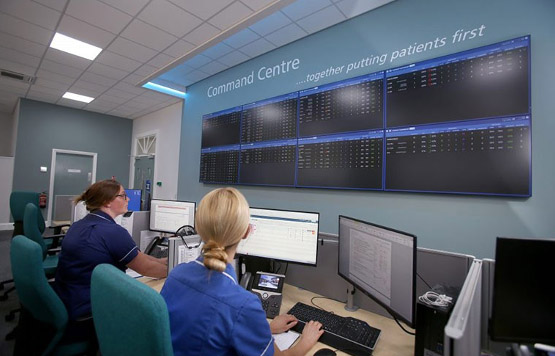Extend strategy: Bradford, UK
Bradford Royal Infirmary
Another example of a hospital using a command centre to deal with the surge of patient inflow and treatments is the Bradford Royal Infirmary from the Bradford Teaching Hospitals NHS Trust. The trust serves a population of around 500,000 people in Bradford and the surrounding area. It has around 900 beds and employs approximately 5,500 staff members [1]. The clinical Command Centre in the Bradford Royal Infirmary is the first of its kind in Europe.
Through the Command Centre, the hospital gathers 24/7 real-time data via 60 apps or so-called Tiles, which provide insights on different levels: the patient, ward, hospital and system. The continuous collection of data allows the hospital to make faster decisions and prioritise and allocate resources. All information is displayed and monitored on screens in the Command Centre room but can also be accessed on staff’s tablets and mobile phones.6 With an already fully operating Command Centre, the Bradford Royal Infirmary could quickly adopt measures to start collecting and monitoring COVID-19-related data. For this, they added two new Tiles to manage the COVID-19 patient base and the critical resources involved in their care, such as intensive care unit (ICU) beds, negative pressure rooms and ventilators. One of the effects was that the Tiles helped identify COVID-19 positive patients on a general ward, which showed the life-saving potential of working in real-time [2].

References
[1] GE Healthcare. COVID-19 shows the life-saving potential of working in real-time [Internet]. 2020 [cited 2021 Feb 8]. Available from: https://www.healthcareitnews.com/news/emea/covid-19-shows-life-saving-potential-working-real-time
[2] REGA. Coordination centre for intensive care units [Internet]. 2020 [cited 2021 Feb 8]. Available from: https://www.rega.ch/en/news/news-from-the-world-of-rega/detail/coordination-centre-for-intensive-care-units